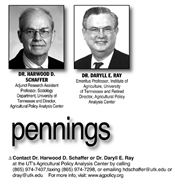|
Biochar Boosts Carbon Levels In Soils

The extremes in weather we have seen in the last decade, including the widespread flooding of US agricultural fields this past spring, have triggered us to wonder what agriculture might look like in 20 or 30 years. Will we see a significant change in the agricultural production model?
In some ways the answer is clear. There will be significant changes over the next 30 years; the only question is the nature of those changes.
If present trends continue, the future will bring increasing concentration within the input sector with even fewer companies controlling the production and marketing of the farm chemicals and seeds that farmers must purchase. Likewise, when farmers market their production, they will face fewer buyers. Even if farm size increases significantly, it will be difficult for even the largest of farmers to wrest more than a marginal increase over the prices received by average sized farmers.
But there is also another trendline that has been developing over the last 15 or 20 years driven by increasingly demanding consumers who are looking for food that meets their quality, environmental, and ethical production standards. More people than ever want organic and minimally processed foods. In addition, grass-fed and free-range meats and eggs are becoming increasingly popular. These consumers want to know more about the producers of their food and the production methods used by those farmers.
Along this line, we see an increasing number of farmers who are concerned about the impact of their activity on both their farm ground and the environment. They are concerned about global warming and understand that changes in their production practices will allow them to both reduce their CO2 contribution to the atmosphere and increase the level of carbon sequestered in their soils.
In our recent climate-smart agricultural practices column (https://tinyurl.com/uwugskq), we wrote about farmers who were in a financial squeeze using conventional agricultural practices and began implementing soil-building practices like the use of cover crops and expanded crop rotations.
We have been reading about resilient agricultural practices and one in particular that has received little attention to date is the use of biochar to increase the carbon levels in the soil. While the use of conservation tillage and cover crops contribute to increasing soil carbon levels in the medium-run, eventually these contributions are balanced out by soil respiration. In addition, the soil-carbon sequestered in these soils can quickly be lost by a return to conventional tillage practices.
By way of contrast, biochar remains locked in the soil for periods of time that are estimated from centuries to millennia. The Amazon River Valley is home to carbon rich terra preta de indio (black) soils that are up to nearly 7 feet in depth and as much as 2000 years old.
When we were younger, it was thought that tropical soils are so warm and receive so much rain that they are not able to maintain enough fertility for sustained agricultural production, but the discovery of the terra preta soils in the late 20th century puts lie to that belief.
The biochar particles in these anthropogenic (human created) soils hold on to nutrients that are essential for plant production, allowing for sustained agricultural production even in tropical climates. It is estimated that these soils sustained a population upward of 1 million people before the arrival of Europeans with diseases like small pox. The resident population had no resistance to these diseases and the area suffered a population collapse, allowing for the regrowth of the Amazon rainforest that many of us read about in our grade school days.
In the 2006 translation from French of Mazoyer and Roudart’s “A History of World Agriculture” no mention was made of these soils or their productivity. Instead they wrote, “whether it be on the desert coast [of Peru], in the Andes, or in the Amazon, it is uncommon to find any area that combines all the conditions of temperature, water supply, and slope that would allow cultivation.”
A detailed discussion of biochar and terra preta soils will be the focus of next week’s column. For a more detailed discussion of biochar we recommend “The Biochar Solution: Carbon Farming and Climate Change” by Albert Bates and “Burn: Using Fire to Cool the Earth” by Bates and Kathleen Draper. ∆
DR. HARWOOD D. SCHAFFER: Adjunct Research Assistant Professor, Sociology Department, University of Tennessee and Director, Agricultural Policy Analysis Center
DR. DARYLL E. RAY: Emeritus Professor, Institute of Agriculture, University of Tennessee and Retired Director, Agricultural Policy Analysis Center
|
|